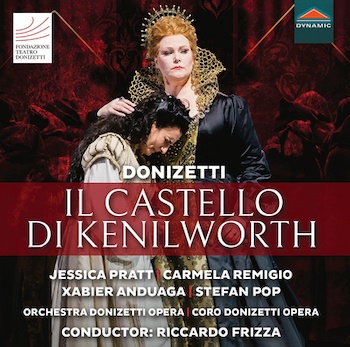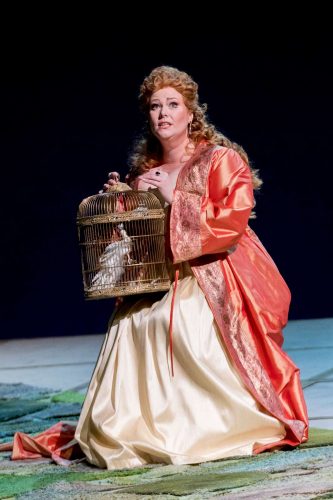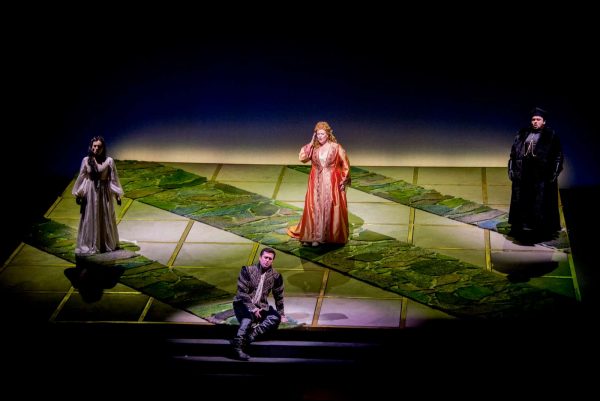Opera CD Review: A Tenor as a Villain? Donizetti’s Unusual Two-Tenor Opera Gets a First — and Fine — Recording
An 1829 opera about Elizabeth I and her supposed lover — enlivened by underhanded threats, virtuous resistance, remorse, and an attempted poisoning — proves well worth reviving.
Gaetano Donizetti, Il Castello di Kenilworth
Jessica Pratt (Elisabetta), Federica Vitali (Fanny), Carmela Remigio (Amelia), Xabier Anduaga (Leicester), Ştefan Pop (Warney), Dario Russo (Lambourne); Donizetti Opera Orchestra and Chorus, conducted by Riccardo Frizza
Dynamic 7834.02 [2 CDs] 131 minutes
Click here to purchase.
Donizetti’s long-forgotten 1829 opera Elisabetta al Castello di Kenilworth is a charmer, if a charmer can be at times intense, even coruscating.

This world-premiere recording of the opera in its original version (with two major tenor roles) conveys well its many strengths. Donizetti revised the work a year later. That version has been recorded twice, under Alun Francis and under Jan Latham-Koenig. (The latter recording, featuring Mariella Devia, was much praised by opera authority Charles Parsons in American Record Guide, January/February 1994.) The work is normally referred to by the four-word title in our heading, perhaps because “Elisabetta” might get it confused with two other operas by Donizetti that likewise feature England’s Queen Elizabeth I: Roberto Devereux and Maria Stuarda. (Both of those have been on the Met’s roster in recent years and have been featured in High-Definition transmissions, including stylish and powerful singers such as Sonya Radvanovsky, Joyce DiDonato, Elza van den Heever, Elīna Garanča, and Matthew Polenzani.)
Castello is a major work, unaccountably neglected. The dramatic situations are as well drawn by the librettist (Andrea Leone Totolla) as they are in better-known Donizetti operas, and the music is of consistently high quality. Of course, it sounds a lot like other Donizetti works, just as Rossini sounds like Rossini, and Verdi (in a given decade) like Verdi. But I tried testing the work for predictability, and found that I was frequently surprised by what came next: one phrase does not necessarily determine the next, nor one chord the next chord. More basically, a new number (say, an aria with assisting secondary characters, or a duet or quartet) will be announced by some fresh-sounding rhythmic motive in the orchestra that grabs our attention and makes us wonder what is coming next.
The sense of variety and constant newness comes in large part from the variety of situations that the librettist built in. The plot derives indirectly from a novel by Sir Walter Scott (Kenilworth: A Romance, 1821) that freely imagined what might have happened when (or if) Elizabeth I visited Robert Dudley, Lord Leicester, at his castle. Leicester—pronounced here the Italian way: Lay-chess’-terrr—has married his beloved Amelia but has insisted that the marriage be secret, for he hopes to become the queen’s favorite and thereby take the throne. Presumably Amelia would remain his clandestine wife. Leicester tells his squire Warney to bring Amelia to some safe hiding place before the queen arrives. Warney does so, in hopes of forcing Amelia to love him instead. Bit by bit, all of this secrecy unravels, allowing for multiple duets involving threats, virtuous resistance, hurt feelings, fear of losing power, remorse, an attempted poisoning, and—finally—forgiveness for Leicester and Amelia (from the queen).

Jessica Pratt (Elisabetta) in Il castello di Kenilworth at the Donizetti Opera Festival. Photo: Gianfranco Rota.
Castello is often praised for its powerful, extended Act 3 scene between Elisabeth and Amelia, which anticipates in some ways the scene between the same queen and Mary Queen of Scots in Maria Stuarda. Even more notable, in some ways, are the strikingly different duets between Amelia and Warney (in Act 1) and between Leicester and Warney (in Act 2), and the quartet that ends Act 2, lusciously tuneful and with all of the main characters voicing their respective feelings aloud—or to themselves. Along the way, there are also notable passages for male chorus (Leicester’s retainers) and a marvelous procession for Elizabeth’s much-awaited entrance toward the end of Act 1.
The recording was made during a run of performances in November-December 2018 in Bergamo, Italy.
The result feels very much like a performance: one can hear some stage movement and the left-right, upstage-downstage placement of the singers. There is hearty applause after many numbers, which I was happy to join in the first time around but which may annoy on repeated listening.
The cast members are a mix of Italians and foreigners, but all pronounce the language well and meaningfully and also phrase and ornament their lines with natural-sounding flair. (Several of them are featured in this trailer for the production.) Carmela Remigio, an exquisite lyric soprano, handles the demands of the role of Amelia well, getting better and better as the work unfurls. Jessica Pratt, a dramatic-coloratura soprano, produces marvels in the intense role of the queen. (Here she is at her impressive best, in the opera’s finale—apparently filmed by someone in the audience.) At four spots she adds super-high notes that are firm but wiry; the operagoers in Bergamo are audibly thrilled. Some of her long notes show a slow vibrato or wobble. Pratt is scheduled to sing Donizetti’s Lucia at the Met this coming season. I hope she takes some time off beforehand in order to shine as clearly and consistently in the entire role as she does in most of her role here.
The conflicted Leicester is the marvelously gifted Spaniard Xabier Anduaga, who can handle anything the score demands of him: low or high, soft or loud. He adds an unwritten high note that is as brassy and full as a trumpet fanfare, throwing the audience into a near-frenzy.
The nasty Warney is the kind of role that, by Donizetti’s day, was normally assigned to a baritone; indeed, Donizetti revised the part for baritone in the second version of the opera. The recording uses the original version, and I love hearing the unusual sound of two very different tenors socking it out. Ştefan Pop (from Romania) brings a meaty, edgy sound that nicely contrasts with Anduaga’s smoother (yet still substantial) one. Indeed, the many virtues of all the singers are nicely described in several online reviews of the production, such as this one at the Bachtrack site (whose name is a wordplay on “backtrack”).

Il castello di Kenilworth at the Donizetti Opera Festival. Photo: Gianfranco Rota.
Riccardo Frizza knows when to push on and when to yield so a singer can shine. The orchestra sounds fully capable, reminding me how standards have risen everywhere nowadays. I loved some brief solos by the clear-toned, sensitive clarinetist and English-horn player (both of them unnamed). Amelia’s Act 3 aria of despair is a must-hear for its unusual combination of harp and glass harmonica, reflecting, in their fragile shimmering, Amelia’s stream-of-consciousness recollections of lost happiness. (Some recent performances and recordings of Lucia di Lammermoor have used a glass harmonica in the Mad Scene, following an indication in Donizetti’s manuscript. Clearly the dramatic context in Lucia struck him as similarly apt for such a weirdly shimmering instrument. In the end, though, he replaced it with a flute, as is correctly shown in published scores.)
The libretto and informative booklet essay are in Italian and in generally reliable English. One point in the synopsis is misleading: Leicester does not say that “he himself” (as the translation has it) will take Amelia away from the castle; rather, he is instructing Warney to carry out this task. The news thrills the squire, because it will result in his being alone with, and having power over, Amelia. Yes, the situation is meant to be creepy and to put both men in a bad light.
The synopsis lacks track numbers, and the track list, weirdly, mentions only the first character to sing in each track (even in a duet or quartet). Neither the track list nor the libretto indicates whether a given track is an accompanied recitative, an aria, or a duet or larger ensemble. The essay gives no indication what the “autograph revision by Giovanni Schiavotti” consisted of. Such a fine world-premiere recording of the original version of a major Donizetti opera should be accompanied by more informative and user-friendly reading matter. That’s part of what CD collectors pay for and appreciate. (People on tighter budgets, or just wanting to sample, will find the entire recording available—broken up into dozens of several-minute-long tracks—on Spotify, YouTube, and other streaming services. There is also a DVD and a Blu-Ray Video; I have not watched these.)
Ralph P. Locke is emeritus professor of musicology at the University of Rochester’s Eastman School of Music. Six of his articles have won the ASCAP-Deems Taylor Award for excellence in writing about music. His most recent two books are Musical Exoticism: Images and Reflections and Music and the Exotic from the Renaissance to Mozart (both Cambridge University Press). Both are now available in paperback; the second, also as an e-book. He contributes to American Record Guide and to the online arts-magazines NewYorkArts.net, OperaToday.com, and The Boston Musical Intelligencer. His articles have appeared in major scholarly journals, in OxfordMusicOnline (Grove Dictionary), and in the program books of major opera houses, e.g., Santa Fe (New Mexico), Wexford (Ireland), Glyndebourne, Covent Garden, Bilbao, and the Bavarian State Opera (Munich).
Tagged: Dynamic, Gaetano Donizetti, lisabetta al Castello di Kenilworth
